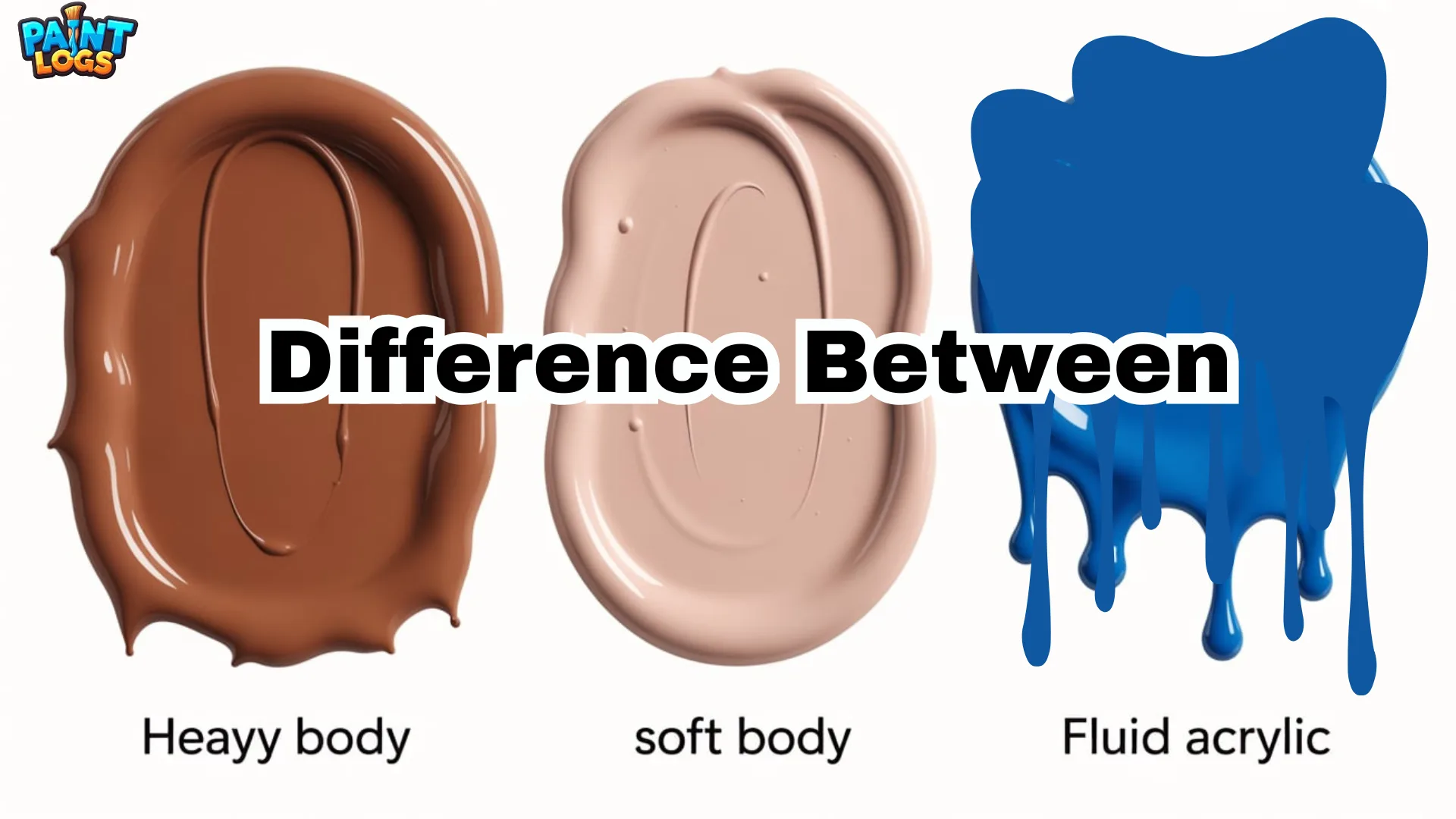When choosing the right acrylic paint for your project, understanding the main differences between heavy body, soft body, and fluid acrylic paint is key. These paints vary in consistency, pigment load, blending behavior, and ideal uses. Heavy body acrylics are thick, buttery, and great for texture and brushwork. Soft body acrylics are smoother and better for blending or detail work. Fluid acrylics are thin and pour easily, making them perfect for glazing, pouring art, and fine detail. Whether you’re layering impasto textures or creating smooth gradients, knowing which acrylic type to use will elevate your results and match your artistic style.
In this article, we’ll explore the main differences between heavy body, soft body, and fluid acrylic paints. Understanding these distinctions will help you choose the right paint for your creative projects, ensuring better results and more artistic freedom.
Key Takeaways:
- Heavy body acrylic paint is thick and retains brushstrokes, making it ideal for textured and layered artwork.
- Soft body acrylic paint is smooth and creamy, perfect for glazing, airbrushing, and detailed work.
- Fluid acrylics are thin and liquid, making them great for pouring, staining, and creating smooth blends.
- Fluid acrylics are especially useful for techniques like pouring, staining, and creating abstract art with smooth layers.
- Uses: Heavy body acrylics work well for textured layers, impasto, and palette knife techniques. Soft body acrylics are great for glazing, pouring, and airbrushing, offering smooth coverage.
- To choose the right paint, go for heavy body for texture, soft body for detailed work, and fluid acrylics for smooth, flowing effects
What is Heavy Body Acrylic Paint?
Heavy body acrylic paint is a thick, highly pigmented paint with a creamy, buttery consistency. It has a higher viscosity compared to other types of acrylic paints, meaning it is dense and retains its brushstrokes and texture once applied to a surface. This makes heavy body acrylics ideal for creating textured artworks, as the paint holds its shape and can be layered without flattening out.
Due to its consistency, heavy body acrylic paint is commonly used in techniques such as impasto, where paint is applied thickly to create a three-dimensional effect on the canvas. It’s also great for creating dynamic textures, bold brushstrokes, and visible layers. Artists can use palette knives or brushes to manipulate the paint, allowing for more control over the texture and appearance of their work. Heavy body acrylics are also highly opaque, meaning they provide strong, vivid colors and excellent coverage, even on dark surfaces.
Popular brands like Golden, Liquitex, and Winsor & Newton offer heavy body acrylic paints, which come in a wide range of vibrant hues.
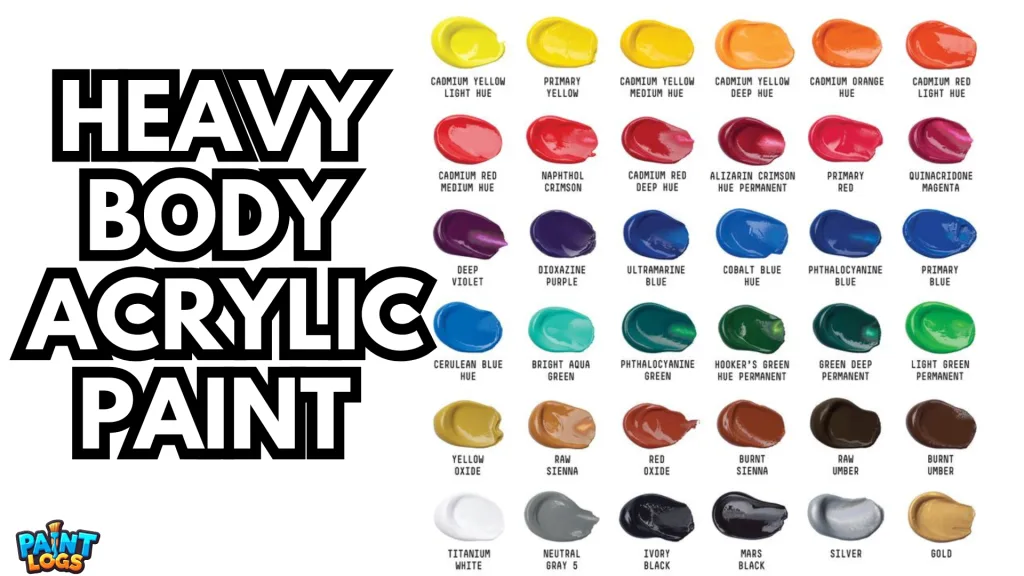
What is Soft Body Acrylic Paint?
Soft body acrylic paint is a type of acrylic paint that has a smooth, creamy consistency but is thinner and more fluid than heavy body acrylics. This makes it easier to spread and blend, providing a more even, smooth application. It has a lower viscosity, so it flows easily from the tube, offering a more controlled application with less texture compared to heavy body acrylics.
Soft body acrylics are ideal for techniques that require finer detail and smoothness, such as glazing (the layering of transparent colors), airbrushing, and delicate blending. These paints can be used to create subtle gradients or smooth, blended transitions between colors. While they still retain a certain thickness that allows for brushstrokes, they do not maintain their texture as well as heavy body acrylics, which means they are less suited for textured applications like impasto.
One of the key features of soft body acrylics is their versatility. They can be used for a wide range of applications, including both fine art painting and commercial techniques. Artists who need more control over blending, mixing, or layering often prefer soft body acrylics due to their smooth and fluid nature. Popular brands, including Liquitex, Golden, and Winsor & Newton, offer soft body acrylics in a wide variety of colors.
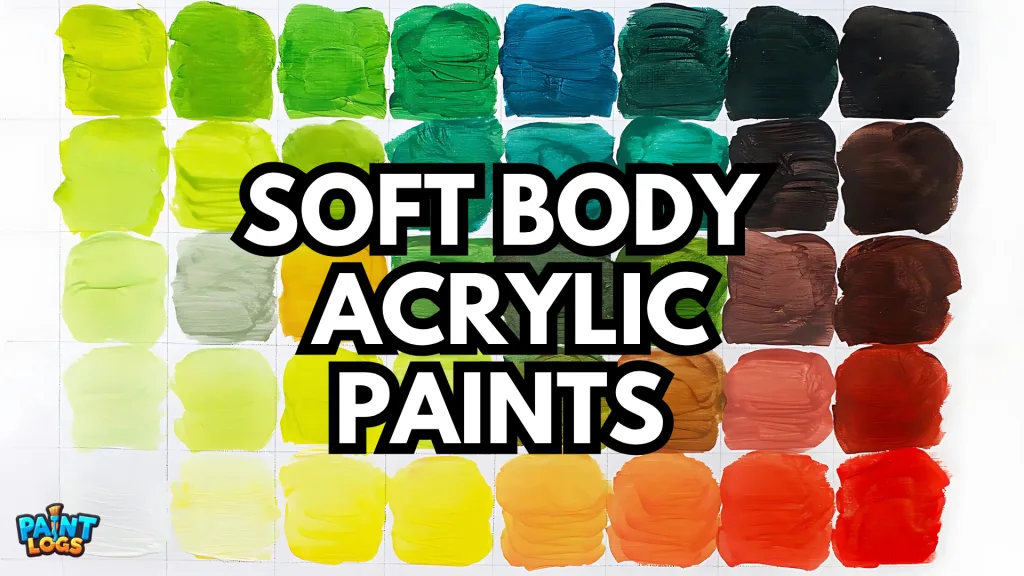
Understanding Fluid Acrylic Paints
Fluid acrylic paints are very thin and runny, with a consistency similar to ink or watercolor. This fluidity allows them to flow smoothly across surfaces and mix easily with other mediums. Due to their high water content, fluid acrylics are often used for techniques where the paint needs to spread or flow, such as pouring art or creating soft blends. These paints maintain rich pigment saturation despite their fluid nature, making them vibrant even when thinned down.
Techniques and Uses of Fluid Acrylics
Fluid acrylics are versatile and can be used for a variety of creative techniques. Their thin consistency makes them ideal for flowing, blending, and glazing effects. Some common techniques include:
Pouring Technique
The pouring technique involves diluting fluid acrylics with a pouring medium to create flowing patterns on the canvas. This technique often produces abstract designs and fluid art, where colors blend together organically. Artists may tilt the canvas or use tools to manipulate the paint, allowing it to flow freely and create unique effects.
Staining Technique
The staining technique involves applying a thin layer of fluid acrylics to a surface and allowing the paint to penetrate the fibers or texture. This technique is commonly used for watercolor-like effects, where the paint is absorbed into the surface, leaving a translucent color. It’s ideal for creating layers of color and subtle textures.
Creating Fluid Art
Fluid art is a popular style that uses the natural flow and blending properties of fluid acrylics. Techniques like pouring, swiping, or tilting the canvas allow the artist to create vibrant, abstract pieces. The paint’s liquidity enables beautiful transitions between colors, making it a favorite for creating organic and fluid designs.
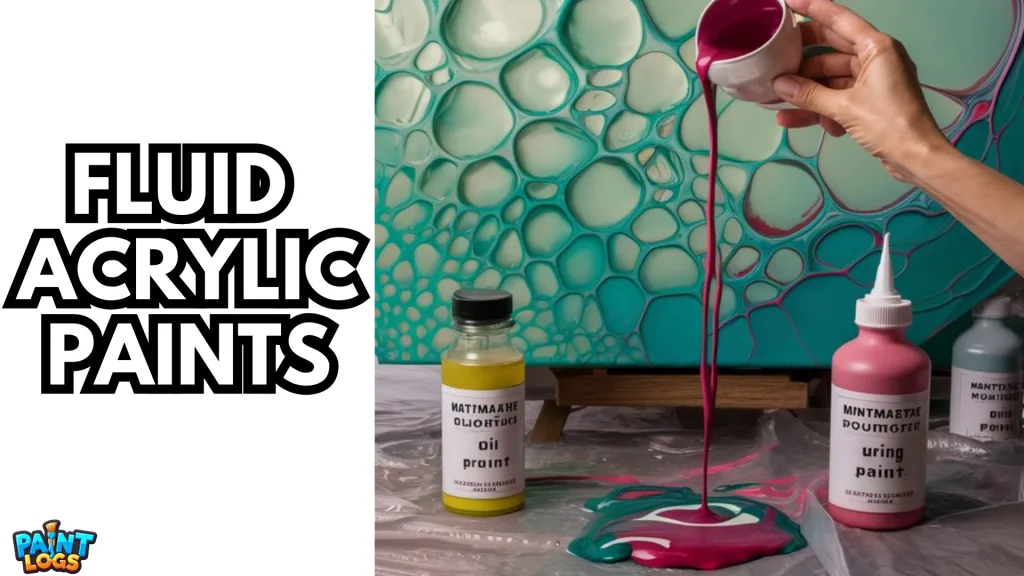
Uses of Heavy Body Acrylics
Heavy body acrylics are best known for their ability to create texture and bold visual impact. They are commonly used in the following ways:
Textured Layers
Heavy body acrylics are perfect for building up thick layers of paint, creating rich textures that stand out on the canvas. Artists can use palette knives or brushes to apply thick layers, adding dimension and depth to the painting.
Blending and Mixing
While heavy body acrylics are thicker than soft body or fluid paints, they can still be blended and mixed effectively. However, their consistency requires more effort to mix, so artists often use mediums to adjust texture and workability.
Impasto Technique
The impasto technique involves applying thick layers of paint to create visible, textured brushstrokes. Heavy body acrylics hold their shape well, making them perfect for impasto, which creates a three-dimensional appearance on the canvas.
Sgraffito Technique
Sgraffito is a technique where artists scratch through a layer of paint to reveal the surface beneath. This works well with heavy body acrylics, which are thick and retain texture. The artist can create intricate designs by scraping into the paint with various tools.
Dry Brush Technique
Dry brushing with heavy body acrylics involves using a brush with little paint on it to create a scratchy, textured effect. This method is effective for adding highlights or for creating a weathered, rough look.
Palette Knife Painting
Palette knife painting is another technique that works beautifully with heavy body acrylics. The thick consistency allows the artist to apply large, expressive strokes and sculpt the paint into various textures, making it ideal for creating impassioned, abstract works.
Underpainting
Underpainting involves creating a base layer of paint to build upon. Heavy body acrylics work well for this technique because they offer strong coverage, allowing the artist to establish a solid foundation for further layers of paint.
Mixed Media Art
Heavy body acrylics are also used in mixed media art, where artists combine different materials, such as paper, fabric, or other paint types, to create a rich, layered effect. The thick texture of heavy body acrylics holds up well when combined with other mediums.
Stenciling and Printing
The thickness of heavy body acrylics makes them suitable for stenciling and printing techniques. The paint holds its form through stencils or printing processes, making it ideal for crisp, defined patterns and images.
Sculptural Effects
Artists can use heavy body acrylics to create sculptural effects, adding real texture and form to their work. By applying multiple layers or using molding tools, heavy body acrylics can be manipulated into three-dimensional art pieces.
Glazing
While heavy body acrylics are not traditionally known for glazing, they can still be used for transparent layers by diluting the paint. This allows artists to create rich, layered effects with a glossy finish, though the paint may need to be thinned out to achieve the desired transparency.
Each of these techniques makes use of the unique properties of heavy body acrylics, enabling artists to create works with depth, texture, and dimensionality.
Comparison Table: Fluid vs. Heavy Body Acrylics
| Feature | Fluid Acrylics | Heavy Body Acrylics |
| Consistency | Thin and runny, similar to watercolor | Thick and creamy, holds shape easily |
| Ideal for | Pouring, staining, fluid art | Texture, sculpting, impasto, thick applications |
| Best Techniques | Pouring, staining, glazing, fluid art | Impasto, sgraffito, dry brush, palette knife painting |
| Use in Mixed Media | Blends smoothly with other media | Adds texture and volume in mixed media art |
| Textural Effect | Smooth, even finishes | Bold, raised textures |
| Application | Best for fluid, abstract work | Best for detailed, dimensional work |
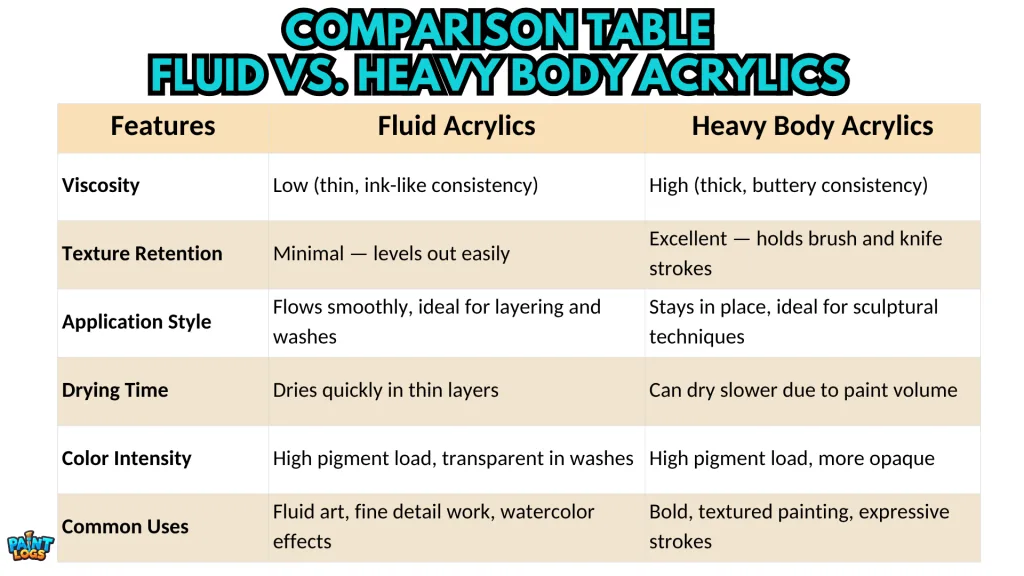
Applications of Soft Body Acrylics
Soft body acrylics are versatile and popular for artists looking for smooth consistency in their painting. These paints are ideal for creating fine details, subtle color blending, and delicate textural effects.
Painting Applications
Soft body acrylics are often used for detailed painting techniques like portraiture, still life, and fine art. Their smooth consistency makes them ideal for creating intricate lines, gradients, and layered washes. These paints are excellent for both traditional brushwork and fine detail application, offering a high degree of control.
Pouring Techniques
Although fluid acrylics are typically associated with pouring techniques, soft body acrylics can also be used for pouring. By mixing with pouring mediums, artists can create smooth, flowing designs, producing controlled, vibrant abstract effects. These paints are perfect for achieving smooth, even coverage in pour-based art without the extreme fluidity of other types.
Glazing Techniques
Soft body acrylics excel in glazing, which involves applying thin layers of transparent paint over a dry layer to create depth and richness. Their consistency allows for excellent control while layering, making them ideal for creating luminous, translucent effects. Glazing can be used to add depth to portraits or landscapes, as the paint’s transparency can enhance subtle color transitions.
Airbrushing
Airbrushing with soft body acrylics is highly effective due to their smooth, fluid texture. These paints work well in airbrush applications, providing a soft, even spray for delicate shading and fine lines. Their consistency allows for detailed control in airbrushing, making them popular for creating gradient effects, soft textures, and smooth transitions in various art forms, including illustrations, automotive artwork, and models.
Soft body acrylics are particularly well-suited for artists who need a versatile paint with smooth application and excellent blending properties for detailed and refined work.

Choosing the Right Acrylic Paint for Your Style
When selecting acrylic paint for your artwork, it’s essential to consider your preferred artistic style and technique. Whether you’re using impasto techniques, creating mixed media art, or exploring fluid art, the type of acrylic paint you choose can significantly impact your results.
Below is a summary of the key characteristics of heavy body, soft body, and fluid acrylic paints, and their suitability for different artistic styles:
| Acrylic Paint Type | Characteristics | Best For |
| Heavy Body | Thick consistency, retains brush strokes, high opacity | Impasto, textured surfaces, bold applications |
| Soft Body | Thin consistency, smooth texture, excellent flow | Pouring, glazing, airbrushing |
| Fluid | Runny consistency, excellent fluidity, excellent transparency | Fluid art, staining techniques, detailed work |
Each type of acrylic paint offers distinct advantages depending on your style. Consider factors like consistency, texture, opacity, transparency, and application methods when selecting the best acrylic paint for your work.
By experimenting with different types and techniques, you’ll discover which paint suits your artistic goals and preferences best.
Exploring Acrylic Paint Brands and Recommendations
Several high-quality acrylic paint brands are available, each offering different characteristics, price points, and quality levels. Below are some popular brands and recommendations based on your needs:
| Brand | Type | Recommendation |
| Golden | Heavy Body | Top-quality, professional-grade paint with excellent pigmentation and consistency. |
| Liquitex | Soft Body | Ideal for mixing, blending, and offering vibrant colors with a smooth texture. |
| Winsor & Newton | Fluid | Great for artists who enjoy pouring or working with thin applications of color. |
| DecoArt | All types | Affordable, accessible brand with a wide variety of colors and finishes suitable for all levels. |
Choosing the right brand depends on your budget and specific requirements. We recommend experimenting with various brands and types to find what works best for you.
Conclusion
Choosing the right acrylic paint depends largely on your preferred technique and the effect you wish to achieve. Heavy body acrylics are great for texture, soft body acrylics for smooth and controlled applications, and fluid acrylics are perfect for abstract designs and fluid-based art. Understanding the differences between these types will allow you to pick the ideal paint for your next masterpiece, whether you’re creating bold textures or subtle details. Don’t hesitate to explore different brands to discover the best fit for your style.
FAQ
What are the main differences between heavy body, soft body, and fluid acrylic paints?
Heavy body acrylics are thick, offer texture, and hold brushstrokes well.
Soft body acrylics are smoother and flow easily, making them great for detailed work and blending.
Fluid acrylics are runny and ideal for pouring, staining, and fluid art techniques.
What are the advantages of using heavy body acrylics?
Heavy body acrylics provide rich color intensity and allow for textured, layered effects. They are perfect for artists who want to create dimension, bold brushstrokes, and visible texture in their artwork.
What techniques and uses are associated with fluid acrylics?
Fluid acrylics are commonly used in pouring techniques, abstract fluid art, staining, and creating smooth gradients. They are also used for glazing and detailed applications where paint needs to flow or mix effortlessly.
How do I choose the right acrylic paint for my artistic style?
Choosing the right acrylic paint depends on your technique. If you want texture and bold strokes, go for heavy body acrylics. For smooth applications and blending, soft body acrylics are better. If you enjoy abstract or pour art, fluid acrylics are ideal.

